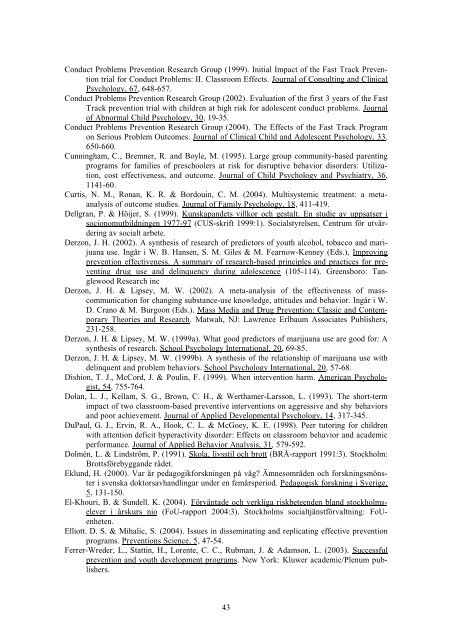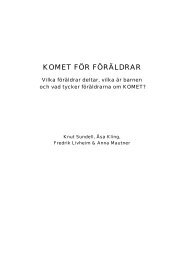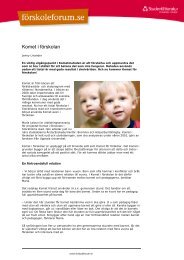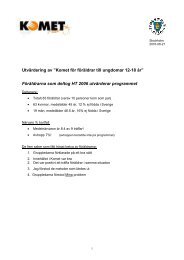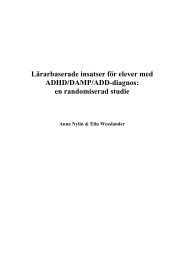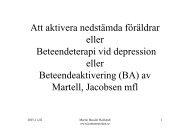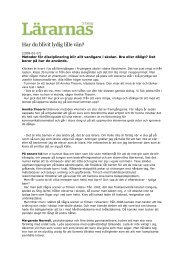EN GRUND FÖR ATT VÄXA - Kometprogrammet
EN GRUND FÖR ATT VÄXA - Kometprogrammet
EN GRUND FÖR ATT VÄXA - Kometprogrammet
You also want an ePaper? Increase the reach of your titles
YUMPU automatically turns print PDFs into web optimized ePapers that Google loves.
Conduct Problems Prevention Research Group (1999). Initial Impact of the Fast Track Preventiontrial for Conduct Problems: II. Classroom Effects. Journal of Consulting and ClinicalPsychology, 67, 648-657.Conduct Problems Prevention Research Group (2002). Evaluation of the first 3 years of the FastTrack prevention trial with children at high risk for adolescent conduct problems. Journalof Abnormal Child Psychology, 30, 19-35.Conduct Problems Prevention Research Group (2004). The Effects of the Fast Track Programon Serious Problem Outcomes. Journal of Clinical Child and Adolescent Psychology, 33,650-660.Cunningham, C., Bremner, R. and Boyle, M. (1995). Large group community-based parentingprograms for families of preschoolers at risk for disruptive behavior disorders: Utilization,cost effectiveness, and outcome. Journal of Child Psychology and Psychiatry, 36,1141-60.Curtis, N. M., Ronan, K. R. & Bordouin, C. M. (2004). Multisystemic treatment: a metaanalysisof outcome studies. Journal of Family Psychology, 18, 411-419.Dellgran, P. & Höijer, S. (1999). Kunskapandets villkor och gestalt. En studie av uppsatser isocionomutbildningen 1977-97 (CUS-skrift 1999:1). Socialstyrelsen, Centrum för utvärderingav socialt arbete.Derzon, J. H. (2002). A synthesis of research of predictors of youth alcohol, tobacco and marijuanause. Ingår i W. B. Hansen, S. M. Giles & M. Fearnow-Kenney (Eds.), Improvingprevention effectiveness. A summary of research-based principles and practices for preventingdrug use and delinquency during adolescence (105-114). Greensboro: TanglewoodResearch incDerzon, J. H. & Lipsey, M. W. (2002). A meta-analysis of the effectiveness of masscommunicationfor changing substance-use knowledge, attitudes and behavior. Ingår i W.D. Crano & M. Burgoon (Eds.). Mass Media and Drug Prevention: Classic and ContemporaryTheories and Research. Matwah, NJ: Lawrence Erlbaum Associates Publishers,231-258.Derzon, J. H. & Lipsey, M. W. (1999a). What good predictors of marijuana use are good for: Asynthesis of research. School Psychology International, 20, 69-85.Derzon, J. H. & Lipsey, M. W. (1999b). A synthesis of the relationship of marijuana use withdelinquent and problem behaviors. School Psychology International, 20, 57-68.Dishion, T. J., McCord, J. & Poulin, F. (1999). When intervention harm. American Psychologist,54, 755-764.Dolan, L. J., Kellam, S. G., Brown, C. H., & Werthamer-Larsson, L. (1993). The short-termimpact of two classroom-based preventive interventions on aggressive and shy behaviorsand poor achievement. Journal of Applied Developmental Psychology, 14, 317-345.DuPaul, G. J., Ervin, R. A., Hook, C. L. & McGoey, K. E. (1998). Peer tutoring for childrenwith attention deficit hyperactivity disorder: Effects on classroom behavior and academicperformance. Journal of Applied Behavior Analysis, 31, 579-592.Dolmén, L. & Lindström, P. (1991). Skola, livsstil och brott (BRÅ-rapport 1991:3). Stockholm:Brottsförebyggande rådet.Eklund, H. (2000). Var är pedagogikforskningen på väg? Ämnesområden och forskningsmönsteri svenska doktorsavhandlingar under en femårsperiod. Pedagogisk forskning i Sverige,5, 131-150.El-Khouri, B. & Sundell. K. (2004). Förväntade och verkliga riskbeteenden bland stockholmseleveri årskurs nio (FoU-rapport 2004:3). Stockholms socialtjänstförvaltning: FoUenheten.Elliott. D. S. & Mihalic, S. (2004). Issues in disseminating and replicating effective preventionprograms. Preventions Science, 5, 47-54.Ferrer-Wreder, L., Stattin, H., Lorente, C. C., Rubman, J. & Adamson, L. (2003). Successfulprevention and youth development programs. New York: Kluwer academic/Plenum publishers.43


